
Pure white is not a common color in the natural world, especially when it comes to snakes. Although unusual, there are some snakes with white colors and patterns. Many all-white snakes in the wild are the result of rare genetic mutations, like albinism and leucism.
However, these luminously white snakes stand out and can be easily seen by predators. Yet, despite their rarity (or perhaps because of it), white snakes hold a strong allure for many people and are coveted in the pet world.
Let’s take a look at some of the beautifully wild and captive-bred white snakes in our world today.
1. California Kingsnake

California kingsnakes are called kingsnakes because they sometimes eat other snakes, like the
king cobra
.
©Creeping Things/Shutterstock.com
The California kingsnake is a subspecies of the common kingsnake. This is a very striking snake with a sharp contrast of colored stripes, splotches, or rings. California kingsnakes can be either brown and red, or black and white. There are many different color morphs of the California kingsnake, both in the wild as well as from selective breeding.
Typical black and white California kingsnakes have dark brown or black bodies, marked with distinct white or pale-yellow rings or bands. These bands can be thin and delicate, or broad and more prominent than the base black coloring. The snake’s head also has a black splotch on top with a distinct white “T” in the middle of it. These snakes are common as pets, but they can also be found in the wild of Northern Mexico and the western regions of the United States.
As extremely popular pets, there are several color variants of California kingsnakes that have been selectively bred in captivity as well. These snakes may be black or white, with black or white rings, splotches, or long stripes running along the length of their bodies.
Reverse-dotted California kingsnakes, for example, are almost completely white with two rows of black spots along their backs. A stripe California kingsnake, on the other hand, has a white belly and black back, with a bright white stripe running down the middle of its back.
2. Bandy-Bandy Snake

The bandy-bandy snake has unique defenses, including “flicker fusion” and curling its body into a hoop.
©Ken Griffiths/Shutterstock.com
The bandy-bandy is a snake endemic to Australia. These snakes have very smooth, glossy scales with black and white (or pale-yellow) banded patterns along the length of their bodies. The bandy-bandy snake typically measures between 20-30 inches in length with a round, slender body, and small head.
There are six species of bandy-bandy snakes that live in various habitats and regions across Australia. These snakes are venomous, but they are not typically aggressive and are rarely encountered by humans. Bandy-bandy snakes are Ophiophagus and only eat other snakes, especially blind snakes.
The bright, contrasting colors of bandy-bandy snakes do not blend in well with their environment. Instead, these snakes burrow beneath soil, rocks, and logs for protection, and typically only come out at night. When faced with a predator, the bandy-bandy snake has two primary methods of defense. The snake moves quickly and randomly, causing its stark black-and-white colors to “flicker” and create confusion, particularly in low lighting. This display is referred to as “flicker fusion”.
This snake’s second defense is quite unique. When threatened, a bandy-bandy snake can coil its body into a “hoop” shape, making it appear much larger and hopefully more threatening to its predator. Because of this, sometimes the bandy-bandy snake is sometimes called a “hoop snake” as well.
3. Common Kingsnake (Eastern Kingsnake)

Common kingsnakes (or eastern kingsnakes) can grow up to 4 feet long.
©iStock.com/JasonOndreicka
The common kingsnake, or eastern kingsnake, is an elegant black snake with thin, white ring- or chain-like markings along the length of its body. Because of this, it is sometimes also called the “chain kingsnake”. Depending on where the snake lives, these white bands are sometimes wider. Their bellies are white or pale yellow with black “chains” or “zigzag” patterns as well. On average, common kingsnakes grow between 36-48 inches long. These snakes live in the southeastern United States, where they hunt and eat small mammals and snakes.
4. Long-Nosed Snake
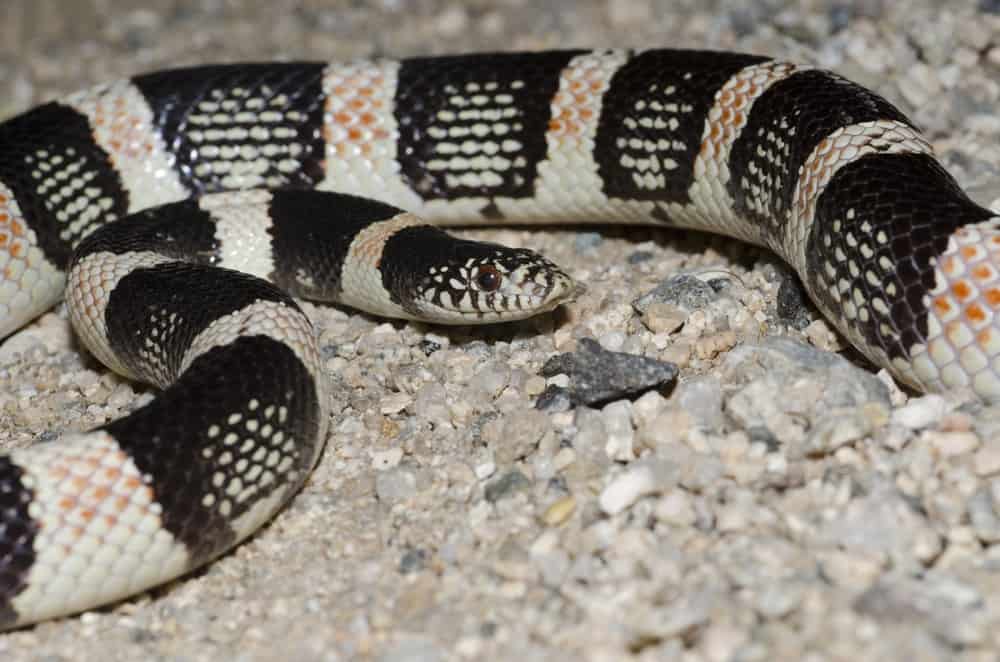
Long-nosed snakes do not usually bite. When threatened, they release a foul-smelling musk.
©Jason Mintzer/Shutterstock.com
The long-nosed snake has a white or cream-colored body with alternating red and black bands or blotches along its back. These crossbands are speckled with tiny white or cream dots, making the snake’s colors and patterns look somewhat pixelated. Sometimes these snakes are only black and white, with little to no red coloring.
Long-nosed snakes are 20-30 inches in length, with distinctly elongated, upturned snouts. These snakes live in a few regions of Mexico, as well as the western United States. Long-nosed snakes prefer dry, arid habitats, like deserts and scrubland, where they hunt and eat lizards and amphibians. These snakes are nonvenomous and rarely bite.
5. Florida Pine Snake
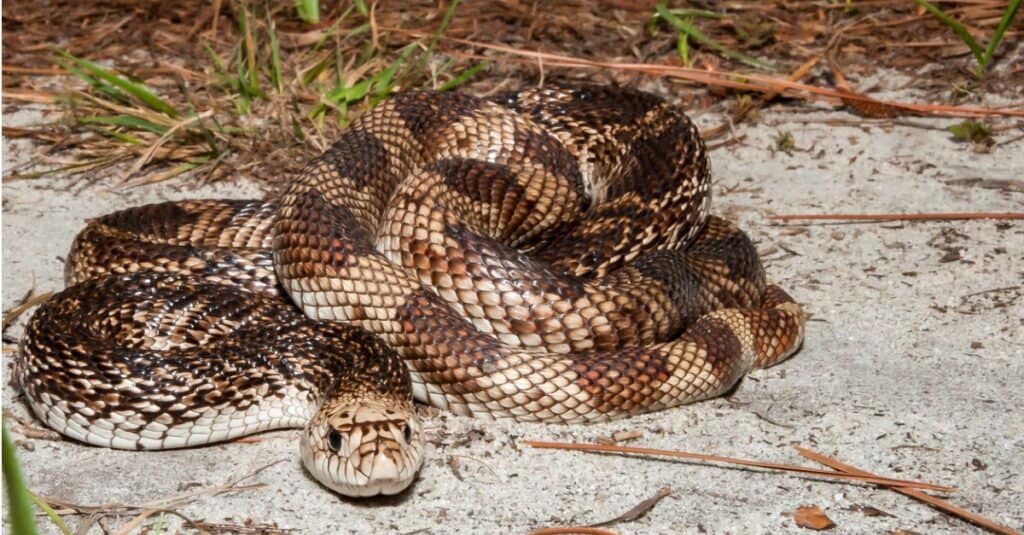
Though non-venomous, the Florida pine snake squeezes its prey to death.
©iStock.com/JasonOndreicka
The Florida pine snake is a large snake with a heavy body, measuring between 48-84 inches in length. This snake is white (and sometimes tan or rust-colored) with dark blotches. On occasion, a Florida pine snake may lack dark blotches, appearing almost entirely white or cream in color, possibly with a few dark speckles here and there. These snakes have small heads with pointed snouts.
The scales above the snake’s eyes are slightly ridged, making it look like the snake is “angry”. Like its name, the Florida Pine Snake lives in Florida, as well as Georgia, South Carolina, and Alabama. In Florida, these snakes are considered “threatened species” and are protected by state laws.
6. Crab-Eating Water Snake (White-Bellied Mangrove Snake)

Crab-eating water snakes have surprisingly small bodies for their 36-inch sizes.
©Robert Ham, CC BY-SA 4.0 <https://creativecommons.org/licenses/by-sa/4.0>, via Wikimedia Commons – License
The crab-eating water snake (or white-bellied mangrove snake) comes in a wide range and variety of colors and patterns. In southern Asia, for example, this snake is often grey or black with some dark blotches. However, in New Guinea and Australia, these snakes can be just about any color, from black and white piebald to yellow, orange, or red with black and white blotches.
Crab-eating water snakes only grow up to 35 inches in length, but they have surprisingly strong bodies. Their strong bodies help to take down their preferred prey: crabs, shrimp, and mud lobsters.
The crab-eating water snake is one of the very few snakes that eats its prey piece by piece, rather than swallowing it whole. This snake uses its strong body to capture crabs, injecting them with paralyzing venom.
When the crab has succumbed, the snake deliberately pulls off each of the crab’s legs, eating them one leg at a time. Crab-eating water snakes will eat the body of smaller crabs; however, with larger crabs, they only eat the legs.
7. Ghost Snake
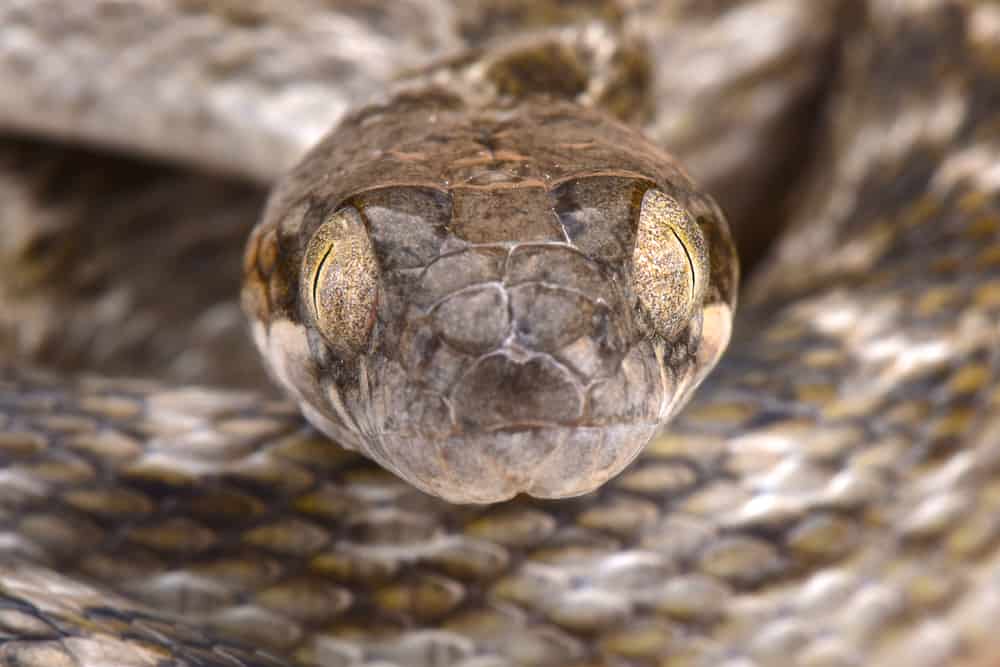
The ghost snake is elusive and rarely seen.
©reptiles4all/Shutterstock.com
The ghost snake is a more recently discovered snake species, first seen in northern Madagascar’s Ankarana National Park in 2014. Its scientific name is “Madagascarophis lolo”. “Madagascarophis” applies to several “cat-eyed” snakes in Madagascar, that have vertical pupils like those of a cat. “Lolo” (pronounced “luu luu”) is a Malagasy word that means “ghost”.
These ghost-like snakes are named for their elusive behavior, as well as their coloring. These snakes quite literally look like ghostly apparitions rather than living snakes. Ghost snakes are extremely pale with light gray and white patterns along the length of their bodies.
Genetic Mutations in Snakes: Albino vs. Leucistic Snakes
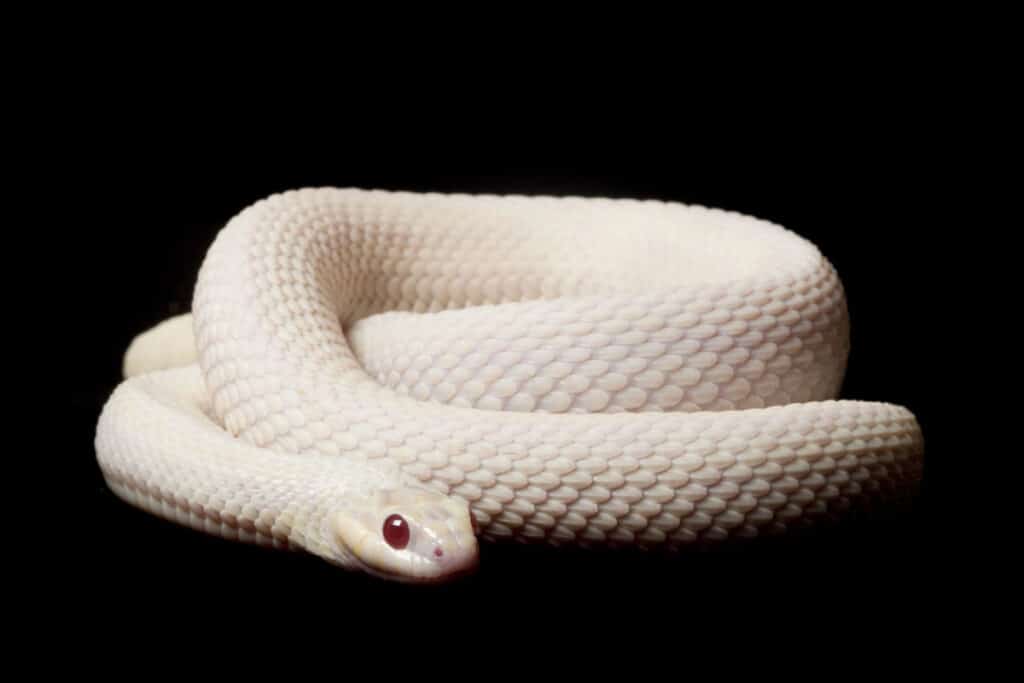
Albino snakes have red eyes and white-colored bodies.
©fivespots/Shutterstock.com
In addition to these “naturally” white snakes, there are often anomalies—that is, naturally colored snakes that are instead born without color due to a rare genetic mutation. Albino snakes, for example, lack melanin in their genetics. Melanin is one of the pigments that create color in a snake’s body, so albino snakes are commonly white.
However, there are other pigments that create color, such as the red or orange shades of carotenoids. Since carotenoid pigments are not affected by albino mutations, albino snakes are white but also have pale pink or pale-yellow undertones. In addition, albino snakes are easy to identify because they have red eyes.
Leucistic snakes, on the other hand, have a much larger range of variability when it comes to color (or the lack thereof). Leucism affects the production of all types of pigmentation in snake genetics, including both melanin and carotenoids. The amount of pigment affected by the mutation, however, varies with each individual snake. Some snakes will have absolutely no color, while others only experience a partial loss of color.
For example, one leucistic snake could be 100% white, whereas another snake may have white patches or spots, and yet another may only have muted colors. One of the easiest ways to tell the difference between an albino snake and a leucistic snake is the color of the snake’s eyes. If a snake has red eyes, it is albino. If a snake has blue eyes or darker-colored eyes, it is leucistic.
8. White Snakes with Albino and Leucistic Mutations
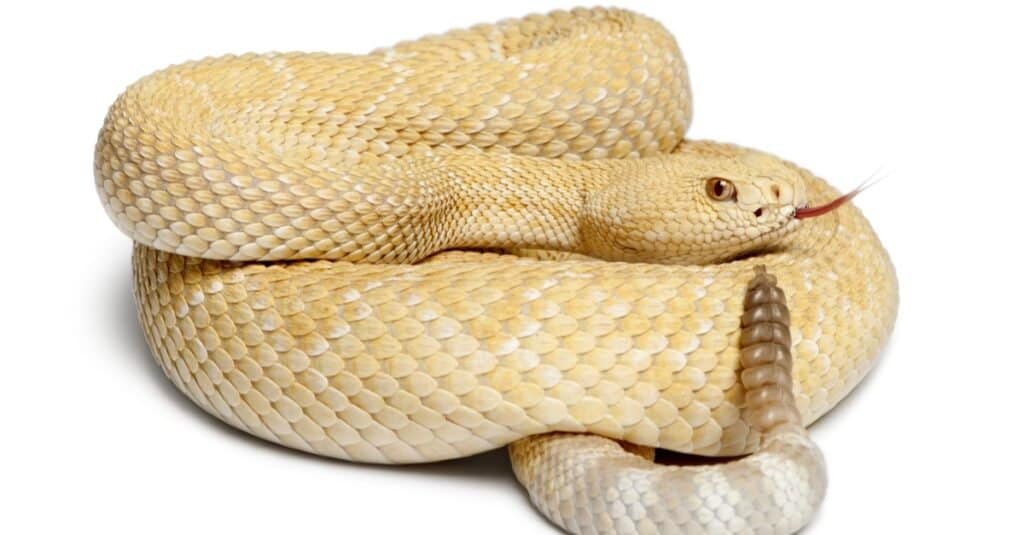
Breeders have spent years breeding captive snakes of various species to have white colors and patterns.
©GlobalP/Shutterstock.com
Both albino and leucistic genetic mutations occur in the natural world. For example, the slaty-grey snake in Australia has a dark brown body. However, in 2017 leucistic slaty-grey snake was found in the Northern Territory. This snake had a beautiful and brilliantly white body, with black, round eyes.
In 2014, the San Diego Zoo introduced Adhira, an extremely rare white monocled cobra. Her name means “lightning” in Hindi, alluding to her stark white coloring. Adhira is a leucistic cobra (not albino), as her eyes are dark rather than red.
White Snakes in the Pet World
Breeders all over the world have spent years breeding captive snakes of various species to have white colors and patterns. Today, there are many types of white-patterned and white-colored snakes that you can find as pets. Here are just a few examples:
9. Ball Python

How much color a pied ball python has depends on its individual genetics.
©Deb Davis/Shutterstock.com
The blue-eyed lucy is a very popular leucistic color morph of the ball python, a snake native to parts of Africa. The pure white bodies of these snakes highlight their striking blue eyes like the perfect combination of sparkling snow and piercing ice.
The ivory ball python, on the other hand, is also white, but instead with a more creamy, ivory tone. The pied ball python has very sharp and distinct blocks of white color, interspersed with the colors and patterns of a typical ball python. It almost appears to be a white python that was strategically painted in a few places or a colored python that accidentally fell into some white paint.
10. Corn Snake
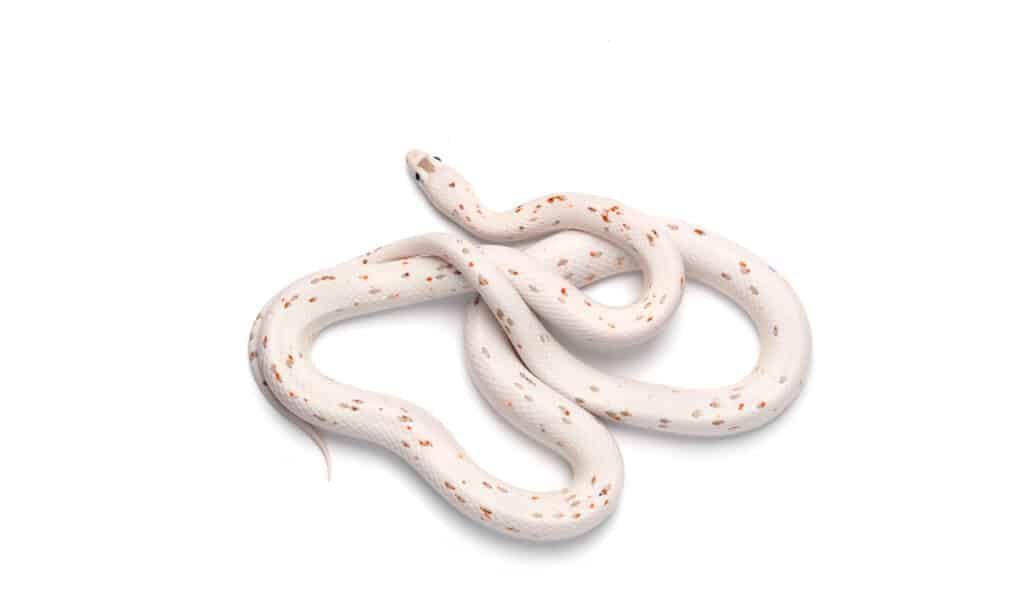
Palmetto corn snakes are very popular color morphs.
©PetlinDmitry/Shutterstock.com
Corn snakes are extremely popular pets because they are docile, hardy, and relatively easy to care for. These snakes come in an endless array of colors and patterns, including, of course, white. Albino corn snakes, for example, have red eyes and white bodies with pink or peach-colored patterns and undertones. A blizzard corn snake, on the other hand, is bright white without these undertones.
These snakes may have red or dark eyes, depending on their lineage. Another popular color morph is the palmetto corn snake. These snakes are bright white as well, but they are also sprinkled with tiny colored speckles along the length of their bodies. Corn snakes are found in the eastern U.S. from southern New Jersey to Florida, and in Louisiana and parts of Kentucky.
11. Reticulated Python

The reticulated python is one of the snakes very popular with expert reptile keepers.
©Opayaza12/Shutterstock.com
Reticulated pythons are the longest snakes in the world and can reach lengths of 20-32 feet! These snakes are also the third heaviest snake in the world and are best suited for extremely experienced snake owners. Phantom morph reticulated pythons reduce the colors and patterns from their original coloring, resulting in snakes that are solid white or have white patterns on a pinkish-white body.
Reticulated pythons typically live 12-20 years, and are native to southern and Southeast Asia, Indonesia, and parts of India and China.
12. Western Hognose Snake
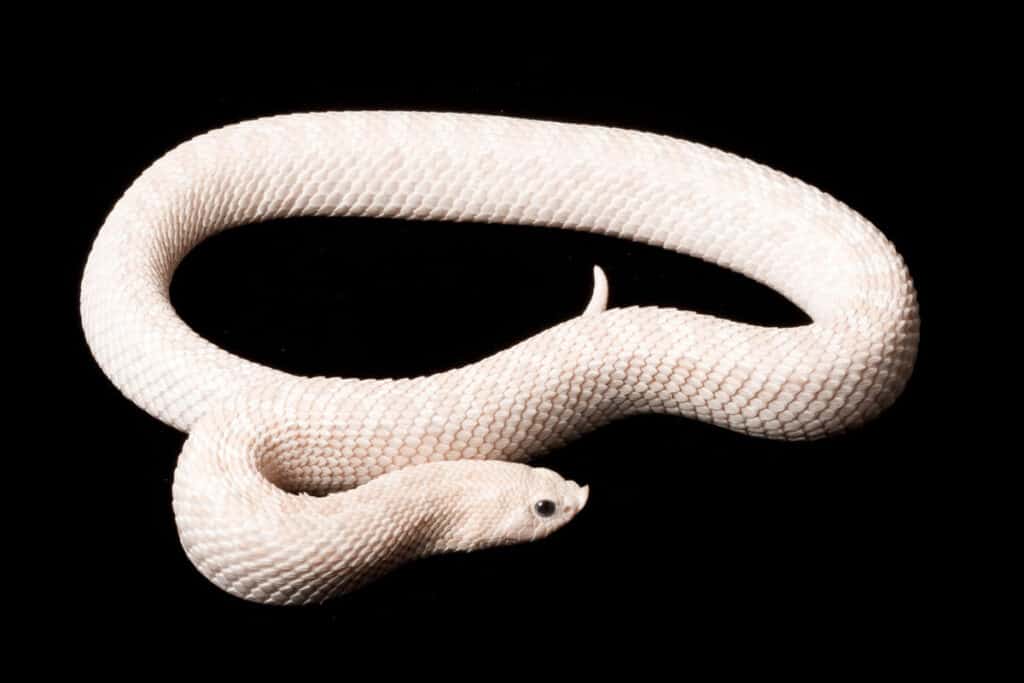
Leucistic morphs of the western hognose snake are stark white but have dark eyes.
©fivespots/Shutterstock.com
The western hognose snake is another very popular pet in the United States, with over 60 different captive-bred color morphs. Albino hognose snakes are white with pink or orange undertones and red eyes. Super arctic Western hognose snakes, on the other hand, have creamy white bodies with black-rimmed brown splotches.
Coral snow hognose snakes look similar to the albino snakes, but these also have additional pale pink and purple patterns along their bodies. A wild western hognose snake has a lifespan of nine to 19 years, and one in captivity is a bit long at 15- 20.
Different Species of White Animals

The
Arctic fox
, also known as the polar fox, is a small fox species native to the Arctic regions.
©bhavdip12/Shutterstock.com
While many species of animals come in white, there are some that are particularly striking for their snowy coat color.
Here are some examples of different species of white animals:
Arctic Fox
The Arctic fox, also known as the polar fox, is a small fox species native to the Arctic regions of the Northern Hemisphere. Their thick, fluffy fur is an excellent insulator, allowing them to survive in the harsh, freezing conditions of the Arctic. In winter, their fur turns completely white, blending in with the snow and ice to provide them with effective camouflage.
Snowy Owl
The snowy owl is a large owl species native to the Arctic regions of North America and Eurasia. They are one of the few owl species that are active during the daytime and are well-adapted to life in the frozen tundra. Their distinctive white plumage helps them blend in with the snowy landscape, while their large, round eyes provide excellent vision for hunting small mammals such as lemmings and voles.
Beluga Whale
The beluga whale, also known as the white whale, is a small cetacean found in the Arctic and sub-Arctic waters of the Northern Hemisphere. They are easily recognizable for their pure white skin, which lacks the dorsal fin found on most other whale species. Beluga whales are highly social animals that use a range of vocalizations, including whistles, chirps, and clicks, to communicate with one another.
White Bengal Tiger
The white Bengal tiger is a rare variant of the Bengal tiger that carries a recessive gene that causes its coat to be entirely white. They are not albinos, but rather a naturally occurring color morph. White Bengal tigers are found primarily in zoos and wildlife reserves, as their white coloration makes them highly visible and vulnerable to predation in the wild.
Conclusion
To sum it up, these are just a few examples of the many different species of white animals found around the world. From the frozen tundra of the Arctic to the lush tropical forests of Asia, white animals can be found in almost every ecosystem on the planet. While they may be rare and elusive, they are a testament to the beauty and diversity of the natural world.
Is a White Snake Symbolic?
White animals have always held a special place in the human imagination, symbolizing purity, innocence, and spiritual transcendence. As to the white snake, specifically, it is considered a symbol of healing, wisdom, and good luck.
The connection to healing comes from ancient Greece where the white snake was associated with Asclepius, the god of healing and medicine. This god was depicted with a long staff that has a snake wrapped around it. That “Rod of Asclepius” with a snake entwined around it, remains to this day as the symbol of medicine. We see this “caduceus” every day at medical offices and pharmacies.

Golden Caduceus, the symbol of medicine showing snakes wrapped around a rod.
©Natykach Nataliia/Shutterstock.com
The idea of a white snake bringing good luck comes from China and Japan where it is often used in art and literature as a symbol of good luck, longevity, and prosperity. The white snake is related to longevity because, like all snakes, it sheds its skin, thus renewing itself. That can be interpreted as being able to self-heal and live on and on.
On the other hand, since many fear snakes as sinister and dangerous, the oddity of a white snake is taken as particularly ominous.
Summary of 12 White Snakes:
| Species | Unique Characteristics | |
|---|---|---|
| 1 | California Kingsnake | While standard California Kingsnakes have black- or dark brown-and-white bodies, many hobbyists have bred different morphs into the species. |
| 2 | Bandy-Bandy Snake | A burrowing snake that exclusively targets other snakes as prey. |
| 3 | Common Kingsnake | Depending on where this snake lives, the white bands on its body may be wider or slimmer. |
| 4 | Long-nosed Snake | This snake has a distinctive nose that is elongated and upturned. |
| 5 | Florida Pine Snake | This snake has a ridge over its eyes that gives it a characteristic “angry” look. |
| 6 | Crab-eating Water Snake | One of the only snakes that eats its prey piece-by-piece rather than whole. |
| 7 | Ghost Snake | This snake is a very recent species, being discovered for the first time in 2014. |
| 8 | Albino/Leucistic Snakes | A leucistic snake has normal eyes, while an albino snake has red eyes. |
| 9 | Ball Python | A very popular snake in the pet trade; different morphs of this snake have white markings or coloring. |
| 10 | Corn Snake | Renowned as a pet snake for its docility and ease of care. |
| 11 | Reticulated Python | They are the longest snakes in the world and can reach lengths of 20-32 feet! |
| 12 | Western Hognose Snake | This snake has a rather long life expectancy in the wild, being capable of living up to 20 years. |
The photo featured at the top of this post is © Kuznetsov Alexey/Shutterstock.com
Discover the "Monster" Snake 5X Bigger than an Anaconda
Every day A-Z Animals sends out some of the most incredible facts in the world from our free newsletter. Want to discover the 10 most beautiful snakes in the world, a "snake island" where you're never more than 3 feet from danger, or a "monster" snake 5X larger than an anaconda? Then sign up right now and you'll start receiving our daily newsletter absolutely free.
Thank you for reading! Have some feedback for us? Contact the AZ Animals editorial team.






